The Intel SSD 335 Series is a progressive update of the SSD 330, which was released in April of this year. Aside from minor software changes, the only major iterative difference with the SSD 335 is the NAND. Where the SSD 330 used 25nm MLC NAND, the SSD 335 takes advantage of a die shrink, thus using Intel’s 20nm MLC NAND. All other hardware components remain the same, including the SandForce SF-2281 controller and SATA 6Gb/s interface. From a performance perspective, the SSD 335 still offers burst throughput of 500MB/s read and 450MB/s write, but does get a boost in IOPS. The SSD 335 posts 4K random read IOPS of 52,000 and random write IOPS of 52,000, which is up from 22,500 and 33,000 respectively in the prior generation SSD 330. One other small change, the SSD 335 will only come in a 240GB capacity, where the SSD 330 came in 60GB, 120GB, 180GB and 240GB capacities.
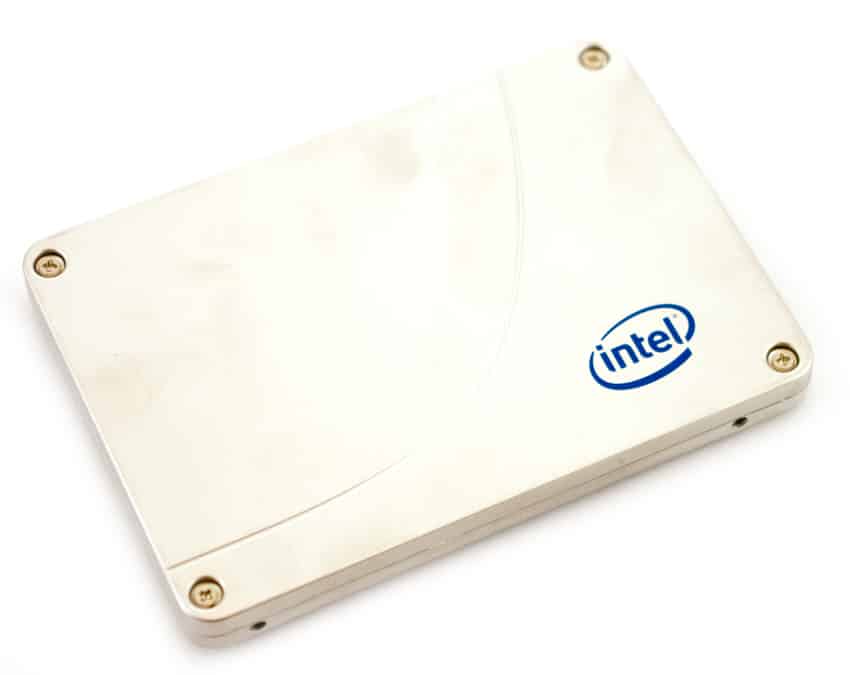
Intel’s SSD 335 falls into the mainstream SSD category, a tier below its enthusiast SSD 520 big brother. It’s interesting then that Intel opted for the single 240GB capacity point, in a market that’s highly price sensitive. The 240GB SSD 335 will probably retail somewhere in the $185-190 price range, which is more or less double the price of the 120GB competition, $50 less than the higher-performing SSD 520 in the same capacity and about the same price as the slightly smaller 180GB SSD 520. While the market is overflowing with options, Intel is providing only one in their mainstream offering. It will be interesting to see if Intel shifts course and expands the line or leverages the SSD 335 to try to drive more consumers upstream to the SSD 520.
Of course the SSD 335 comes with support for Intel’s SSD Toolbox, one of the best suites of software available for managing consumer SSDs. Intel also includes software for cloning a prior drive to the new SSD to make data migration simple. Intel includes a three year warranty with the SSD 335.
Intel SSD 335 Specifications
- Capacity: 240GB
- SandForce SF-2281 controller
- Intel 20nm MLC NAND
- Performance
- Sustained Sequential Read: 500 MB/s
- Sustained Sequential Write: 450 MB/s
- Random 4KB Read: Up to 42,000 IOPS
- Random 4KB Write: Up to 52,000 IOPS
- Form Factor: 2.5″, 9.5mm drive height
- Weight: Up to 78g
- Interface: SATA 6Gb/s
- Power (MobileMark 2007)
- Active: 350 mW
- Idle: 275mW
- Temperature
- Operating: 0°C to 70°C
- Non-Operating: -55°C to 95°C
- Warranty: 3 Years
Design and Build
The Intel SSD 335 shifted away from the normal 9.5-mm two-piece construction of the SSD 320 and SSD 520, instead opting for a top case-half that takes up the full size without the use of an external spacer. The 9.5mm design is a bit curious, given Intel has long offered SSDs in a 7mm drive height, and that’s clearly the direction the market is going, as many new SSDs come with a 7mm drive height standard. By bulking up the SSD 335, it’s almost as if Intel is purposely avoiding the ultrathin compute market with this particular drive.
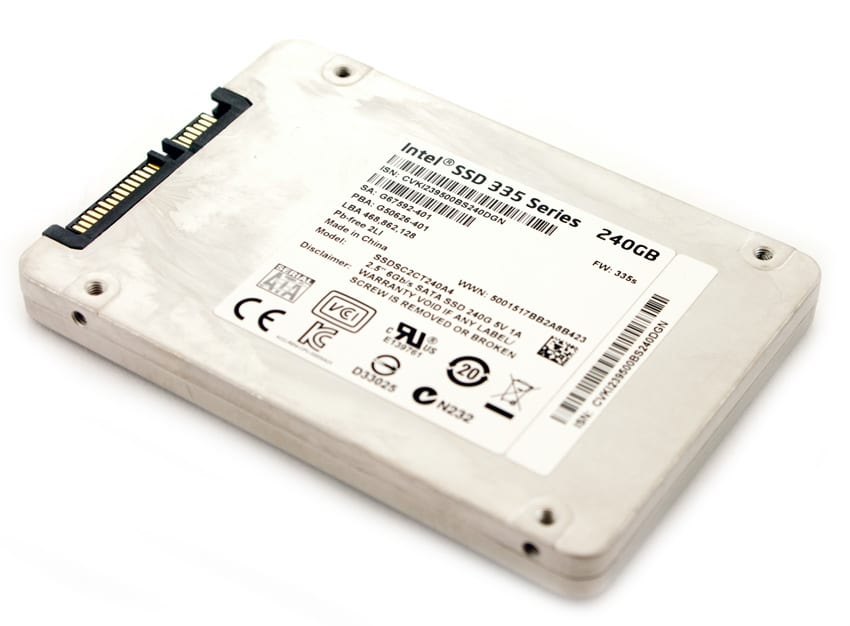
With similar body elements, the only contrasting difference between the Intel SSD 330 and the newer Intel SSD 335 is the top is now bare while the bottom features the main product sticker. This sticker includes information such as model number, capacity, serial number, firmware version, and the like. The front of the SSD 330 has the same SATA power and data connection without any service-mode pins located near it. All firmware updating takes place through the Intel SSD Toolbox, without any hardware intervention.
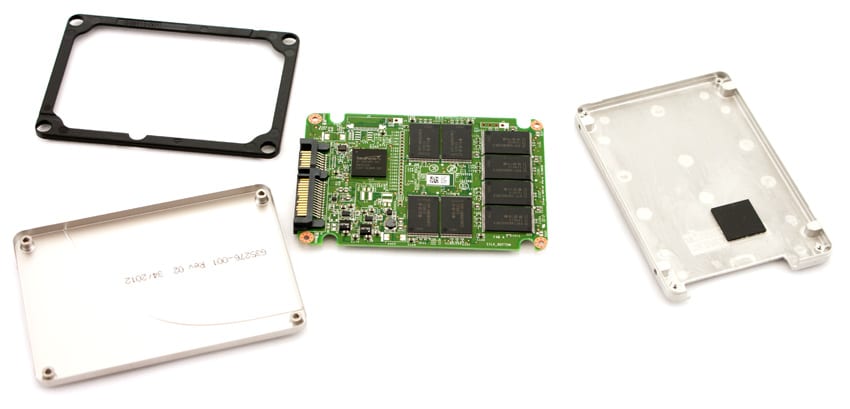
Taking the Intel SSD 335 apart is very easy with a simple Phillips head screwdriver. After removing the four screws located at the corners the top cover easily lift up. Once that is removed you are greeted with the underside of the circuit board, which in this case only includes NAND pieces. New compared to the SSD 320 or SSD 710 layout is a thermal pad on the bottom half of the case to draw heat away from the SandForce controller.
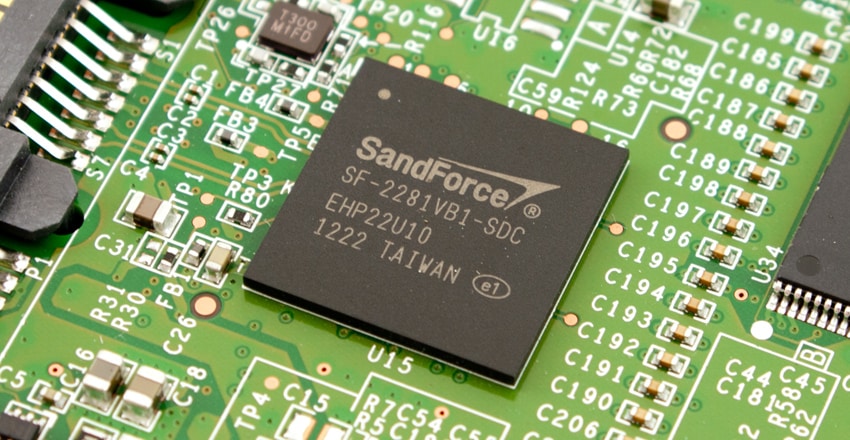
At the heart of the Intel SSD 335 is the LSI SandForce SF-2281 controller. The flash is comprised of sixteen 20nm Intel 29F16B08CCMF2 16GB pieces, which according to Intel are the “cream of the crop” when it comes to selection from the Intel NAND Factory. When you own part of a NAND fab, you can dictate who gets what, and in this case Intel picks the highest grade pieces for themselves. What this means for the consumer is no matter what, if you buy Intel SSDs you get the best Intel components.
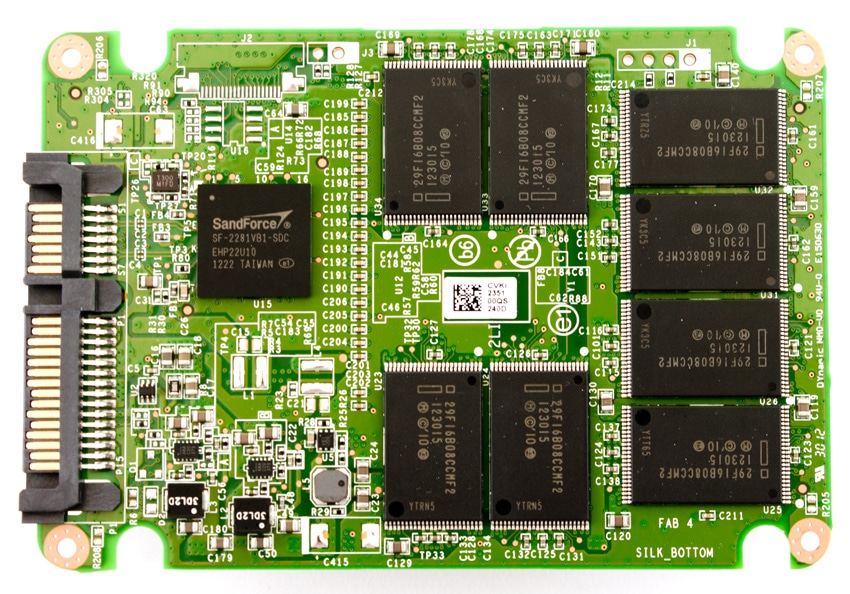
The bottom of the Intel SSD 335 contains the other half of the sixteen 20nm NAND pieces.
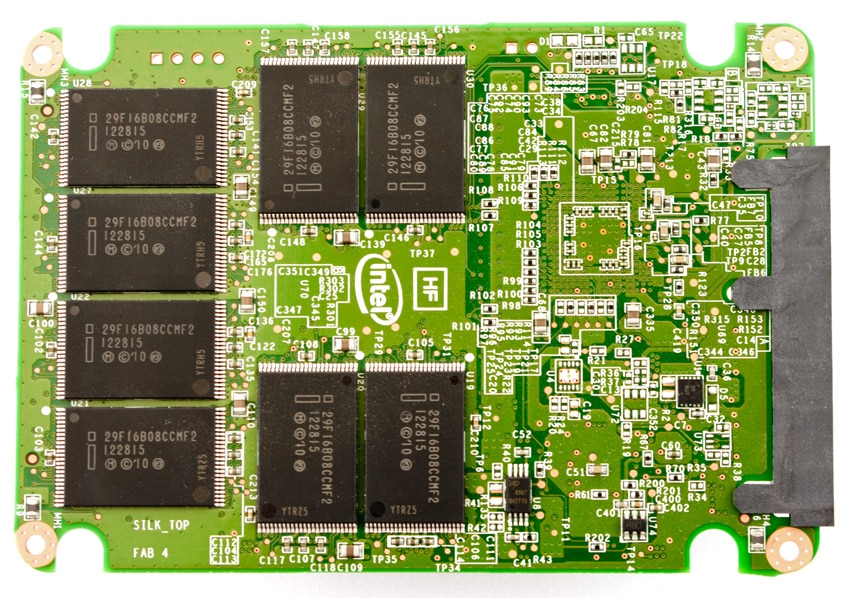
Consumer Synthetic Benchmarks
All consumer SSD benchmarks are conducted with the StorageReview client testing platform. The comparables used for this review include:
- Intel SSD 520 (240GB, SandForce SF-2281, Intel 25nm NAND, SATA)
- Intel SSD 330 (120GB, SandForce SF-2281, Intel 25nm NAND, SATA)
- Plextor PX-M5S (256GB, Marvell 9174, Micron 25nm MLC NAND, SATA)
- Samsung SSD 840 Pro (512GB, 300mhz Samsung 3-core MCX controller, Samsung 2x nm Toggle NAND Flash, SATA)
- Corsair Neutron GTX (240GB, LAMD LM87800, Toshiba 24nm toggle NAND, SATA)
- OCZ Vertex 4 (512GB, Indilinx Everest 2, Intel 25nm MLC NAND, SATA)
Before we dive into our benchmarks, readers must understand that its difficult to make direct comparisons between the previous SSD 330 sample we reviewed and the new SSD 335, since they are difference capacities with different NAND configurations. For that reason, if you are cross shopping this SSD you should instead be making comparisons between it and other 240-256GB SSDs depending on controller configuration. At the time of our SSD 330 review, Intel did not offer the drive in 240GB and didn’t sample the drive to reviewers.
All IOMeter figures are represented as binary figures for MB/s speeds.
Our first test measures straight line sequential read and write performance. In this section the new Intel SSD 335 measured 500MB/s read and 463MB/s read with repeating data and 496MB/s read and 321MB/s write with random data. This puts it in front of the SSD 520 in our first test.
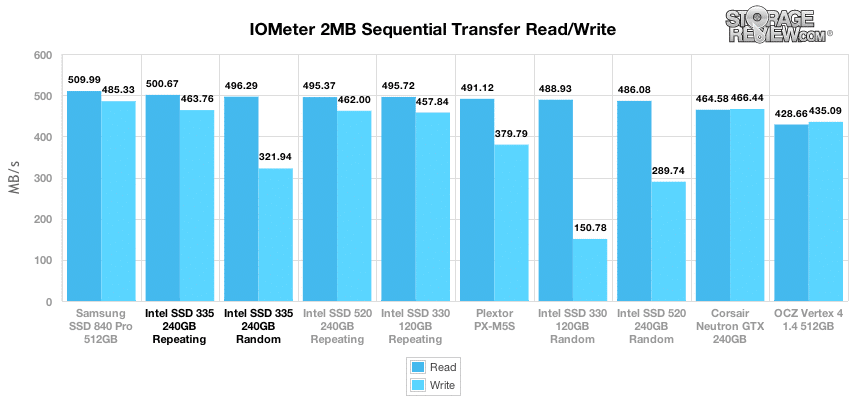
Our next test measures large-block random transfers using both repeating and random data. The Intel SSD 335 performs quite well in this section, measuring 503MB/s read and 462MB/s write with repeating data and 480MB/s read and 319MB/s write with random data. In both datatypes the new Intel SSD 335 is able to out-perform the SSD 520 in write performance.
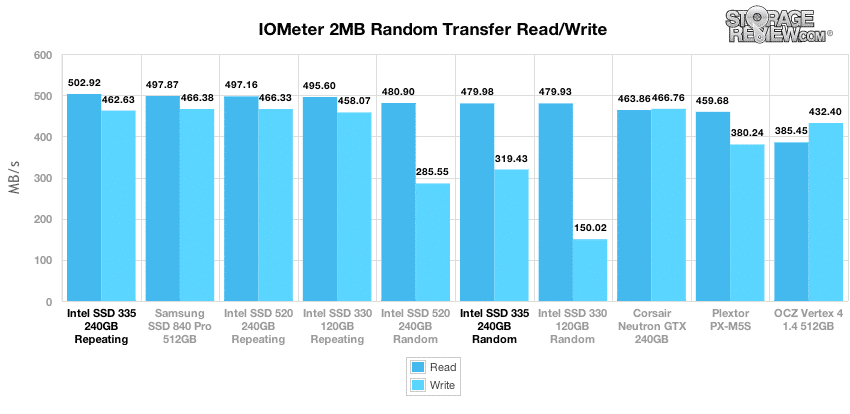
In our next test we measure small-block random 4K performance at a queue depth of 1, which is the bread and butter of any SSD. In this section the mainstream-oriented Intel SSD 335 performs quite well, with read speeds, but slumps behind in write performance compared to the SSD 520 or older SSD 330.
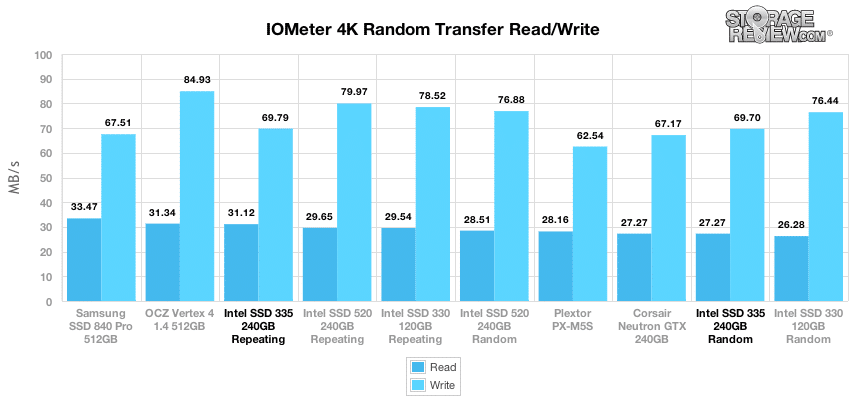
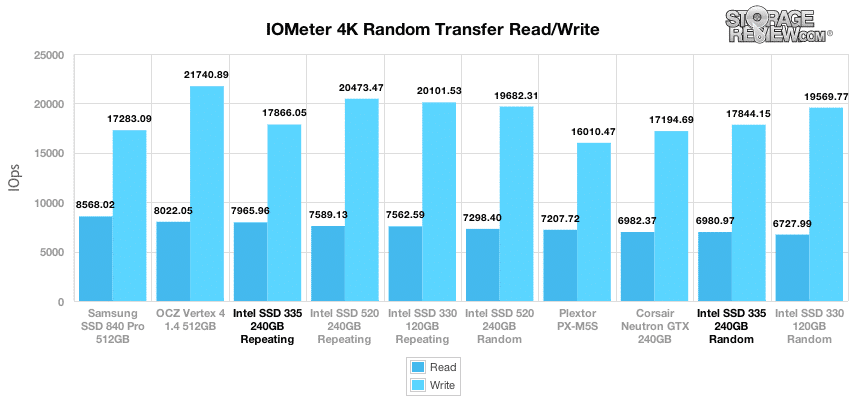
While our first random 4K test measures performance at a low queue depth, our next test scales outstanding I/Os up to 64, similar to what would happen in a multi-tasking environment. In our first expanded 4K random read test, the Intel SSD 335 scales very well, showing similar performance to the SSD 520.
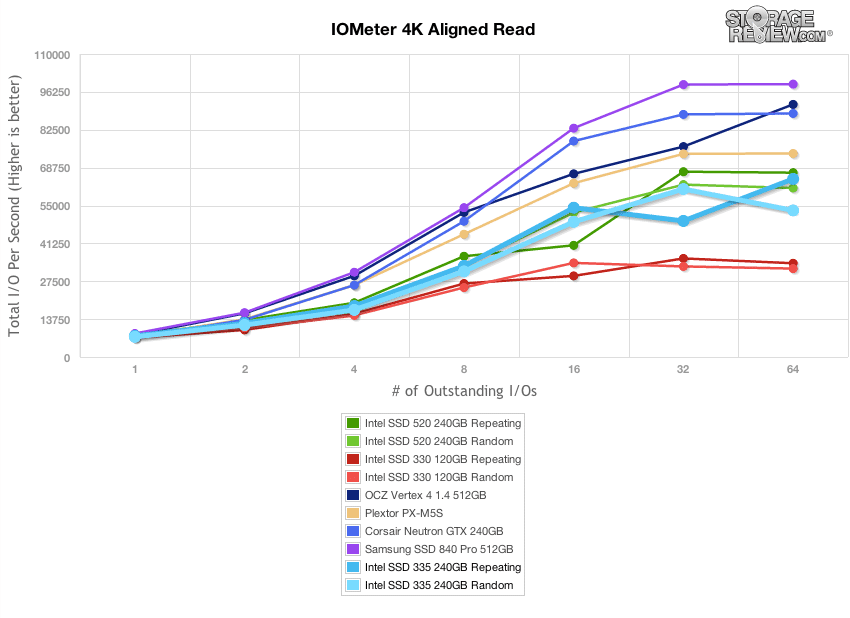
Switching to 4K random write test, the new Intel SSD 335 continues to hold its own with the best of them, coming in second to only the new Samsung SSD 840 Pro.
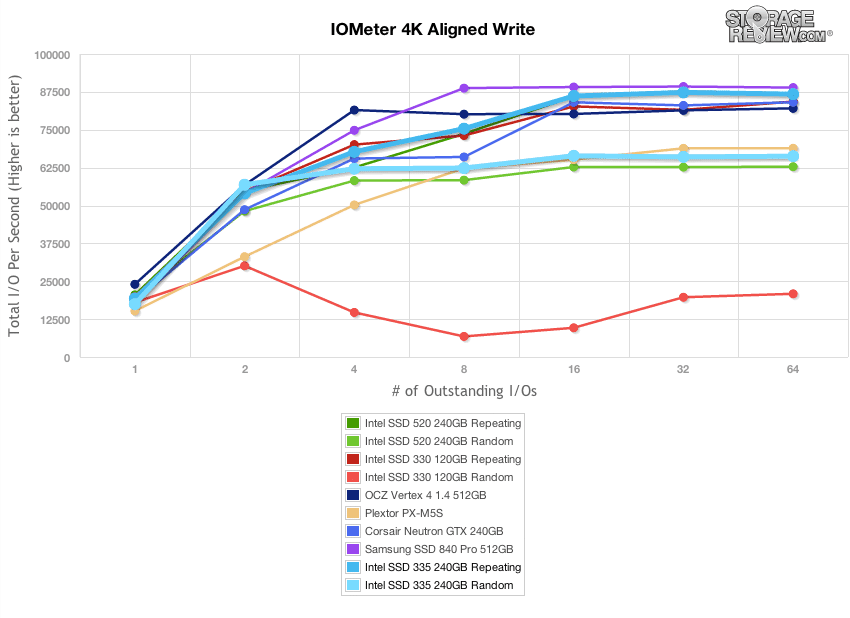
After looking at the throughput in our 4K random transfer tests, we switch our focus to the responsiveness of each SSD. In this section the Intel SSD 335 does well, ranking middle of the pack, but slower than the SSD 520 or SSD 330. Max latency though ranks better than the other two previous models.
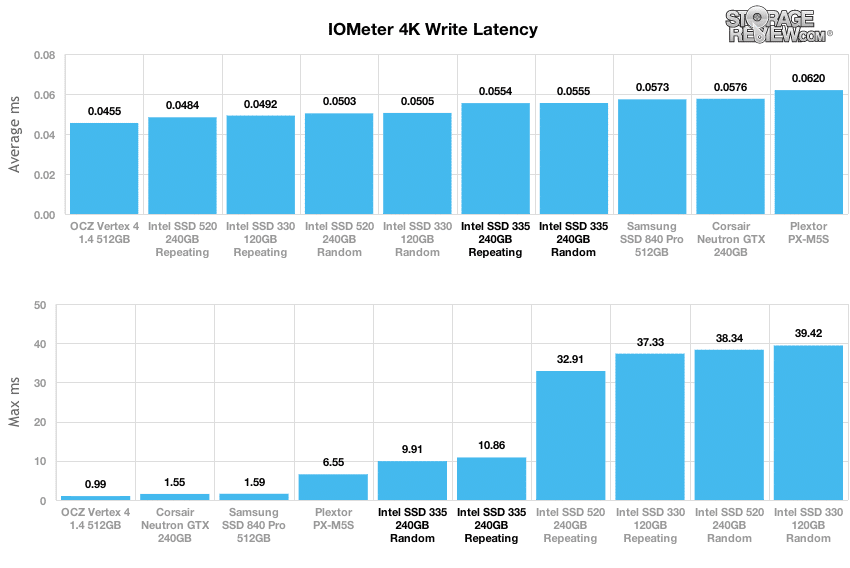
Our final consumer synthetic benchmarks compare the drives in a series of mixed server workloads with a queue depth from 1 to 128. Each server profile has a strong bias towards read activity, ranging from 67% read with the database profile to 100% read in the web server profile.
The database profile features a 67% read and 33% write workload focusing on transfers around 8K in size. In our selection of mixed workloads, the Intel SSD 335 performs at the top of the pack, right behind the Intel SSD 520 in all workloads.
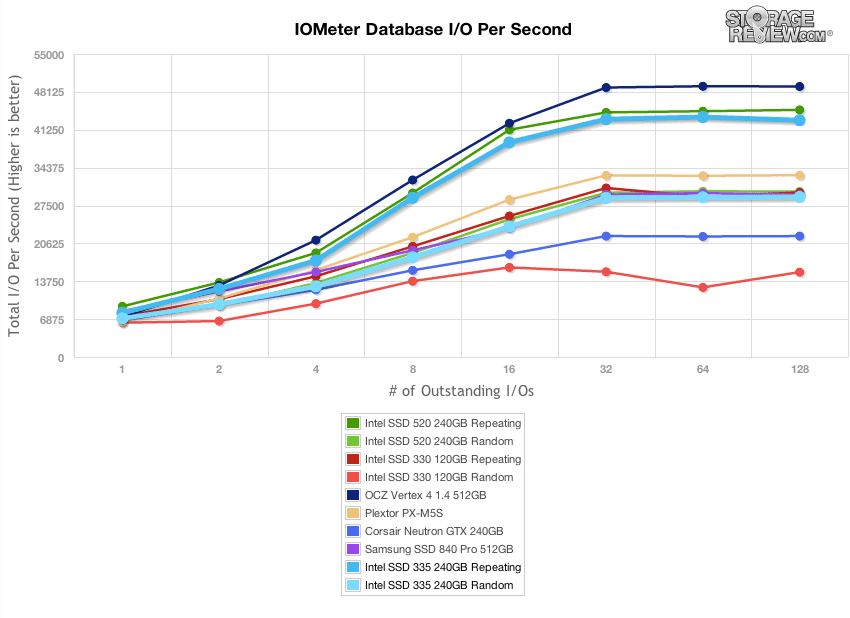
The next profile models file server storage, with 80% read and 20% write spread over transfer sizes from 512B to 64KB.
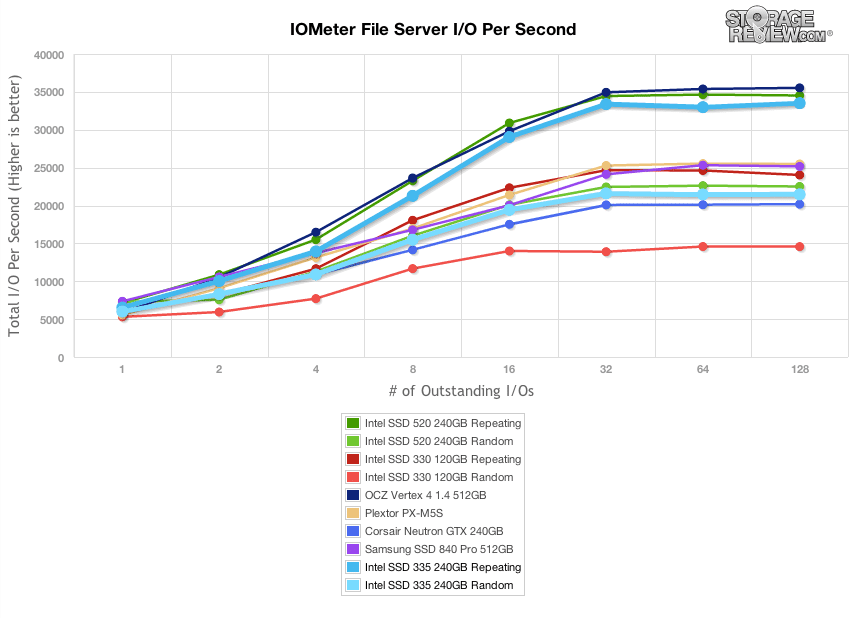
The web server profile is read-only, with transfer sizes ranging from 512B to 512KB.
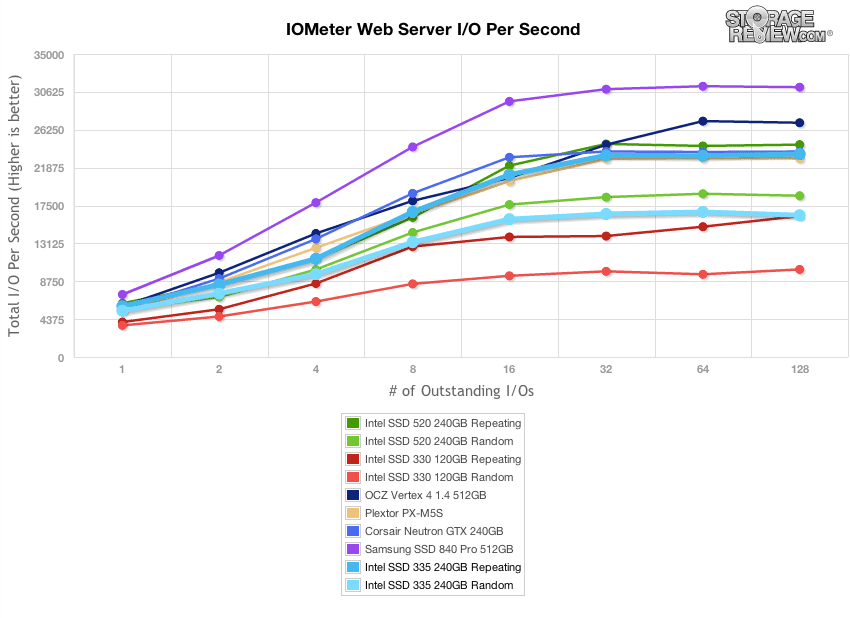
The workstation profile uses 20% write and 80% read operations with an 8K transfer size.
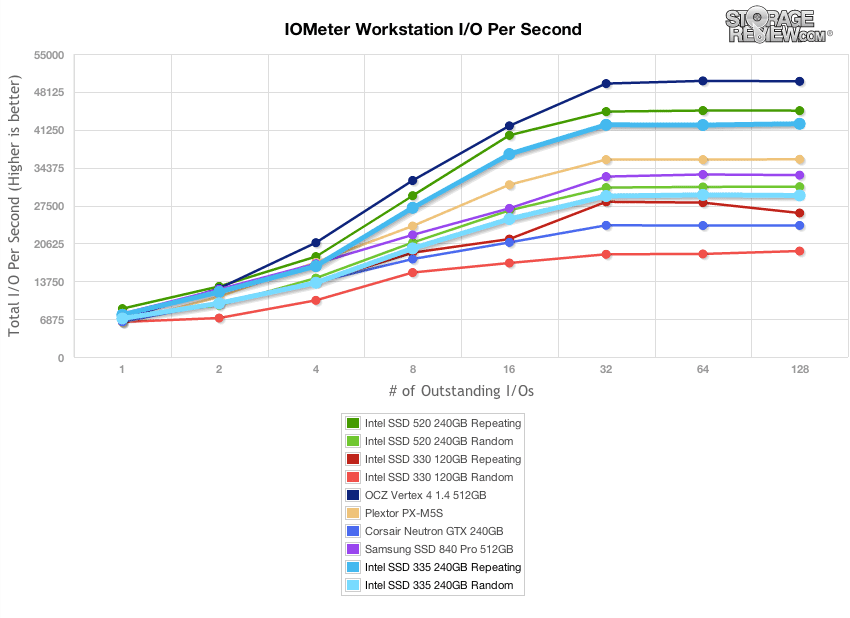
Consumer Real-World Benchmarks
While the results of synthetic benchmarks are important to identify the key strengths and weaknesses of a drive, performance in these tests does not always translate directly into real-world situations. To get a better idea how the Intel SSD 335 will handle itself in the field we will chart StorageMark 2010 HTPC, Productivity, and Gaming traces against comparable drives. Higher IOPS and MB/s rates with lower latency times are preferred.
The first traced is based on use as a Home Theater PC (HTPC). The test includes playing one 720P HD movie in Media Player Classic, one 480P SD movie playing in VLC, three movies downloading simultaneously through iTunes, and one 1080i HDTV stream being recorded through Windows Media Center over a 15 minute period.
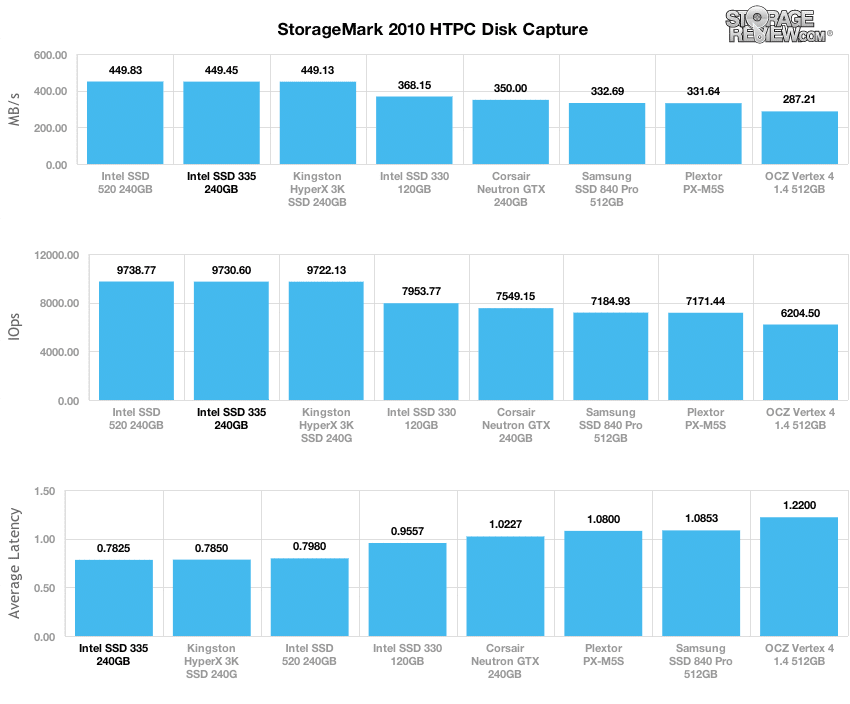
In our HTPC trace the Intel 335 came in right alongside the Intel 520 in throughput and came in with the fastest average latency.
Our second real-life test covers disk activity in a productivity scenario. For all intents and purposes this test shows drive performance under normal daily activity for most users. This test includes: a three hour period operating in an office productivity environment with 32-bit Vista running Outlook 2007 connected to an Exchange server, web browsing using Chrome and IE8, editing files within Office 2007, viewing PDFs in Adobe Reader, and an hour of local music playback with two hours of additional online music via Pandora. In this trace we recorded 4,830MB being written to the drive and 2,758MB being read.
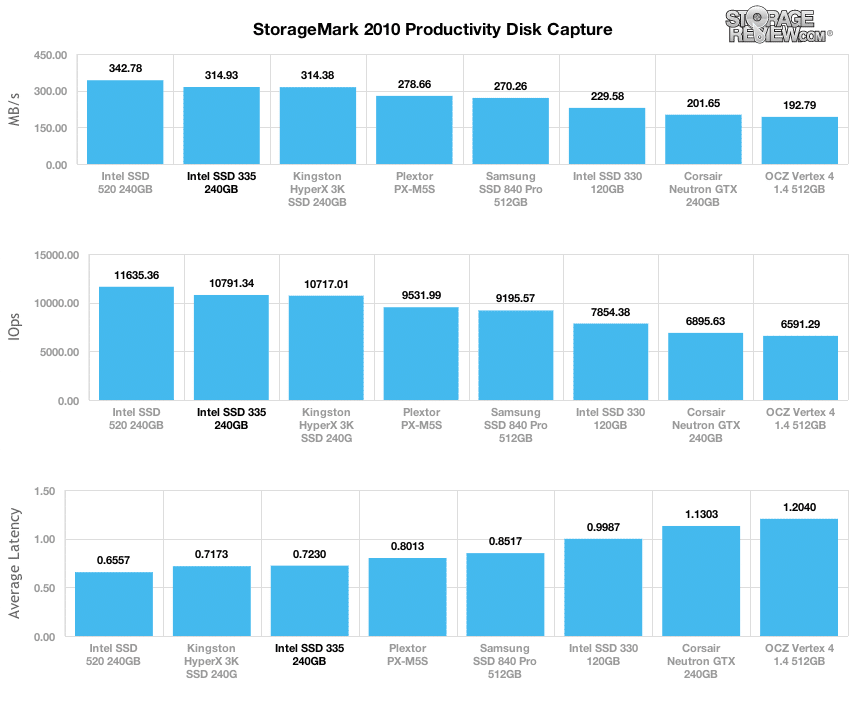
In our Productivity trace, the Intel SSD 335 had an average speed of 314MB/s compared to 342MB/s from the Intel SSD 520.
Our third real-life test covers disk activity in a gaming environment. Unlike the HTPC or Productivity trace, this one relies heavily on the read performance of a drive. To give a simple breakdown of read/write percentages, the HTPC test is 64% write, 36% read, the Productivity test is 59% write and 41% read, while the gaming trace is 6% write and 94% read. The test consists of a Windows 7 Ultimate 64-bit system pre-configured with Steam, with Grand Theft Auto 4, Left 4 Dead 2, and Mass Effect 2 already downloaded and installed. The trace captures the heavy read activity of each game loading from the start, as well as textures as the game progresses. In this trace we recorded 426MB being written to the drive and 7,235MB being read.
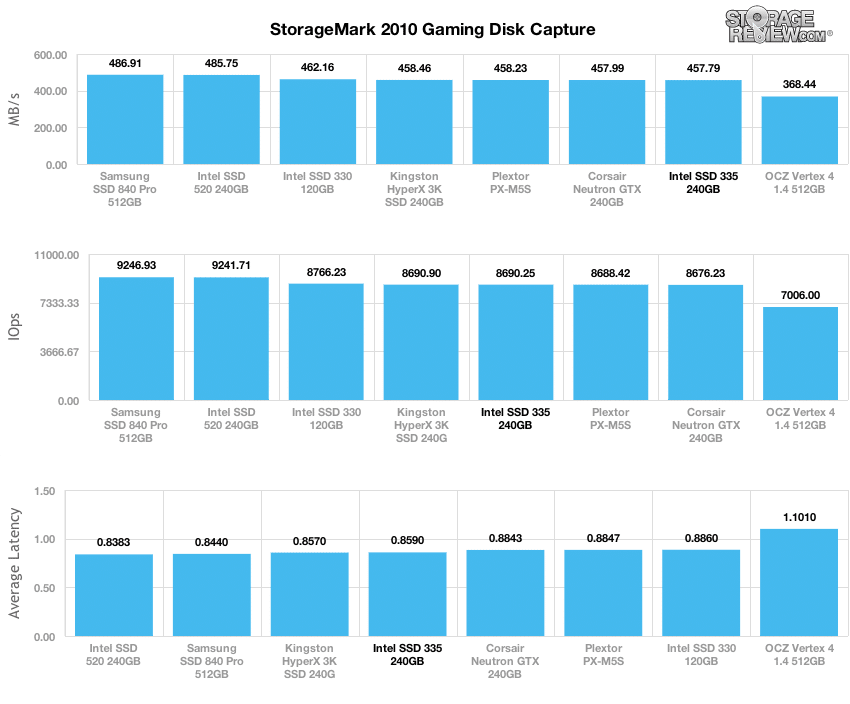
In our third real-world test measuring gaming performance, the Intel SSD 335 came in middle of the pack with an average speed of 457MB/s compared to 485MB/s from the Intel SSD 520 or 462MB/s from the older Intel SSD 330.
Power
With one of the main draws towards SSDs being their lower power consumption for the side effect of extended battery life in notebooks, we pay close attention to how much power these drives consume during our tests. Applying the same read and write profiles that we performed at the beginning of this review, we measure the power used by the SSD during these read or write profiles. SandForce SSDs heavily rely on compression for faster speeds and less write amplification, as a result we measure power with both compressible and incompressible data.

Looking at the power consumption during active power usage, the newer Intel SSD 335 uses the most power in all but write activity, with a significant increase in random write usage. The only area that Intel was able to show a significant improvement in was idle usage, which dropped about a third compared to the Intel SSD 330 or SSD 520.
Conclusion
While the Intel SSD 335 is billed primarily as a NAND die shrink when compared to the prior generation SSD 330, the performance gains in the drive tell a different story. The SSD 335 does much better than the 330 across the board (note: the 330 in this review is 120GB, so it’s not apples to apples) and even beats the enthusiast grade SSD 520 in many spots. Sure the SSD 520 beats out the little brother as tests get more intense, but for the spurts of I/O activity that most mainstream users experience throughout the day, the SSD 335 is definitely a viable option and better than the SSD 520 in some ways. While the drop to 20nm NAND gets the headlines, Intel’s understanding of the SandForce controller has clearly improved as well, there’s simply a vast improvement over the SSD 330 and near parity performance with the SSD 520.
While we love the boost in performance, we are having a hard time with the single 240GB capacity being offered in the SSD 335. For a mainstream SSD who’s purchase decision is almost always heavily weighted by price, not offering a 120GB version is odd. For $100-120, a 120GB SSD 335 would command a large share in a market flooded with vendors who don’t offer the support or performance that Intel and the SSD 335 bring to the table. The decision to go with a 9.5mm drive height is also limiting, cutting out ultra thin notebooks and some light enterprise uses where 7mm drive height is required.
Pros
- Intel Toolbox is a great drive management software package
- Slightly faster performance in large-block transfers
- Not a huge mixed-workload difference between SSD 335 and SSD 520 of same capacity
Cons
- Single capacity point limits consumer choice
- 9.5mm design limits use cases
Bottom Line
The Intel SSD 335 Series offers class-leading performance for a mainstream SSD, even besting enthusiast-grade drives in many areas. While the migration from the SSD 330 is about smaller NAND, it’s clear Intel’s understanding of the SandForce controller has improved as well, as the SSD 335 is a big jump forward from the prior generation.
Intel SSD 335 from Amazon.com



 Amazon
Amazon